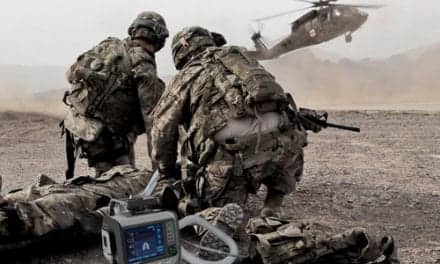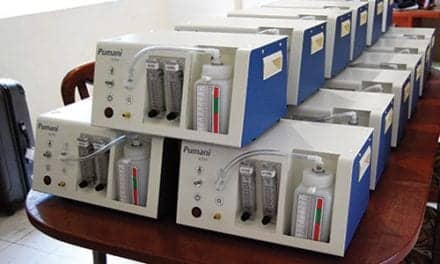In addition to the constant threat of ventilator-associated pneumonia, ventilated patients also face dangers from other less common hospital-acquired infections, including waterborne pathogens that can occur during humidification.
Ever since Louis Pasteur established his germ theory in the 1850s, scientists have been exploring ways to reduce infection rates related to hospitalization. Although the pathogens that caused disease and death in the 19th century may no longer be a health threat today, other organisms continue to persist in hospital settings. According to the Centers for Disease Control and Prevention (CDC), one in 25 hospital patients contracts at least one healthcare-associated infection (HAI); an estimated 722,000 HAIs occurred in US acute care hospitals in 2011. Of those patients, 75,000 died during hospitalization, more than half occurring outside the intensive care unit.
The most common potentially antibiotic-resistant gram-negative bacteria (PARGNB) found in a hospital setting include Acinetobacter baumanii, Pseudomonas aeruginosa, and Klebsiella pneumoniae, reports the National Institute of Allergy and Infectious Diseases (NIAID). A 2008 study1 found P. aeruginosa to be the most common PARGNB, followed by Acinetobacter species and Stenotrophomonas maltophilia.
Although strict hygiene techniques, such as hand washing and wearing gloves and gowns, have become standard practice, sometimes other tactics are necessary, particularly with patients who are mechanically ventilated. Antibiotics are usually the next line of defense. However, the NIAID noted that these bacteria have become more antibiotic resistant in recent years so other tactics must be used to better control infections.
S. maltophilia in LTACHs
MedScape reports that S. maltophilia, an organism of low virulence and frequently colonized in fluids found in patient secretions, must bypass normal host defenses to cause human infection, although healthy individuals typically do not contract disease. However, infants, the elderly, and those with compromised immune systems are more susceptible to infection. Associated with high mortality rates, S. maltophilia infection can be difficult to treat since it is intrinsically resistant to some drug classes and is highly resistant to multiple antimicrobials.
For the most part, S. maltophilia occurs infrequently in a hospital setting and does not typically warrant tracking. Melissa Dankel, public affairs specialist, Division of Healthcare Quality Promotion at the CDC, reported that the CDC does not have data on S. maltophilia infections. “From the healthcare-associated infections we track and the data we receive, we have never seen high enough numbers of S. maltophilia to be able to report those cases out separately,” she said.
Although S. maltophilia is not a common bacterium, it is associated with a significant increase in ICU mortality, longer duration of mechanical ventilation, and longer ICU stays.2 One long-term care facility in Canton, Ohio, (which is part of the Aultman Health Foundation, but independent of Aultman Hospital) experienced a significant outbreak that led to action and successful resolution of the situation.
George Kefalas, MD, board-certified pulmonologist and medical director of Aultman’s Acute Care Specialty Hospital, noted this pathogen is often seen in drowning victims and is commonly found in outdoor water sources. But recent studies suggest the organism is becoming a bigger problem for chronically vented patients, he added. “With the advent of critically ill patients in the ICU on mechanical ventilation, especially in long-term acute care hospitals, we have seen an increase in S. maltophilia,” he said. Aultman’s 30-bed long-term acute care hospital (LTACH) experienced a rash of cases in December 2009.
Most of the facility’s elderly, chronically ill patients were already infected with the S. maltophilia organism upon admission, Kefalas explained. Despite aggressive infection control measures, new positive cultures began to develop in other patients. “We started tracking the situation in January 2010 through March 2010 and found that incidents were occurring every month. This was the impetus for us to find a solution,” he said.
Kefalas, along with Lisa Vacha, RN, director of clinical operations at the hospital, Happy Lundquist, RRT, and other team members, reviewed the situation and devised a plan to boost infection control measures. By March 2010, the LTACH implemented a stringent cleaning regimen. Lundquist spearheaded the infection control plan, which included a strict hand-washing protocol and isolating patients on admission until their cultures came back negative. Patients’ rooms were cleaned twice, since organisms can survive on surfaces. Kefalas said, “If water is near the infected patient and some material gets to another patient’s room, the organism will transfer.”
The staff checked each ventilator to see if one of them could be the source of the problem, according to Vacha. “We wiped the ventilators every day with bleach and isolated the stethoscopes away from the ventilators,” Lundquist added. “We used HMEs [heat and moisture exchangers] and changed the filters daily.”
The sanitation efforts made a slight difference, but the facility did not experience a significant reduction in the infection rate. At that point, the team at Aultman consulted with Brad Rogers, ventilation sales representative at Dräger, to find a solution to the problem. “I spent time with the therapists and reviewed their cleaning process. Everything looked perfect, but I noticed a lot of water in the circuits from humidity,” said Rogers.
“The patients coming in on HME needed to go on active humidity. I figured the bug might be growing in the water, so we tried to eliminate that as a source,” Rogers explained. “It stands to reason that if a patient coughs up bacteria and sputum and it contacts the water, something could grow. Even if the patient rolls or if a patient is being rolled by nursing, without knowing it, the ventilator fluid could lavage the patient. This is an inherent problem with active humidity.”
Solving the Problem
At the time, the hospital was using a heated, humidification circuit and, even though the device used sterile water, the team wondered if this could be where the bacteria was settling. “We surmised that the organisms were colonizing in the patient’s respiratory secretions and looked at optional ways to provide heat while on mechanical ventilation,” said Kefalas.
So in June 2010, Rogers conducted a mini-trial using a coaxial dry circuit with a filter/HME combination, which is very effective with patients who are able to support their own humidification. Both short-term ventilation patients—those on mechanical ventilation 24 to 36 hours—and patients on long-term ventilation are good candidates for this type of treatment, according to Rogers.
He explained that moisture has frequently presented a problem with ventilation. In the winter, patients typically don’t experience many significant issues with moisture. However, in the summer when the air conditioning is turned on, rainout becomes a common issue. “There are problems with limitations of humidity. Too many cold spots in a room causes rainout,” he said.
Fortunately, Rogers’ trial proved to be the solution for the Aultman LTACH. Lundquist reported, “As soon as we changed from wet to dry circuits, there were no more cases. Since 2010, we have admitted patients with positive S. maltophilia cultures from outside the facility, but have had no new cases in our facility.” Vacha also noted that weaning rose from 50%-60% to 70%-80% once the circuits were changed; the presence of S. maltophilia had a direct relationship with weaning progress.
Kefalas pointed out that a regular hospital does not usually see elevated infection rates from this organism in critically ill patients. “However, the patient population in an LTACH is ripe for S. maltophilia. These patients spend 20 to 30 days on ventilation and they are older. Their immune reserves are low so they are susceptible to all sorts of infections,” he said.
Not only does switching to dry circuits solve a bacterial problem, but it also can decrease expenses, according to Rogers. He cited one facility that changed its entire fleet to dry circuits and saved $13,000. “There is a double cost savings benefit. First is the quantifiable cost of the circuit,” he said. “The patient is not on the vent for a long time. He can get out of the LTACH and into rehab.” Also, the cost of treating the infection is eliminated when no infection occurs.
A facility can experience improved workflow as well. Rogers pointed out that sloshing in the device from excessive moisture could cause ventilator alarms to sound, prompting nurses and respiratory therapists to interrupt their work and run to the patient. With the dry circuits, this problem was eliminated.
Ralstonia Contamination

Investigations by Vapotherm, the Food and Drug Administration (FDA), and the CDC concluded that no source of contamination could be traced to the manufacturing of the product; rather, it was determined that Ralstonia was fairly common in tap water used by the 2000i to humidify the airway gas. The company recalled the Vapotherm 2000i and initiated a high-level disinfection protocol and a revision to the labeling, which advised the use of sterile water.
Kolnsberg explained that to reduce the incidence of illness related to waterborne pathogens, a humidification system’s fundamental design should provide the means to reduce the probability of introduction, growth, and inhalation of pathogens. To provide a more effective and user-friendly solution, Vapotherm introduced the Precision Flow, which received FDA 510(k) clearance in 2008.
“Unlike the 2000i, the Precision Flow is built with a completely separate, disposable, closed system water path, which uses sterile water for inhalation,” he said. “The sterile water is introduced into a sterile, single-use disposable by using aseptic technique to spike a sterile water bag. Therefore, when the water enters the circuit, it has not come into contact with any nonsterile environments or surfaces.”
Kolnsberg added, “The likelihood of pathogen inhalation is further reduced by passing the sterile water through a hollow fiber with an average pore size that is smaller in size than a 0.22 micron sterilizing grade filter as part of the airway gas humidification process. The body temperature, 44 mg/L humidified gas is then delivered to the patient through a tri-lumen body temperature, water-jacketed delivery tube that prevents condensation rainout in the tube. This again reduces the probability of pathogen growth by the elimination of stagnant, warm water pools found in traditional, heated wire systems in which pathogens can grow.”
Balancing Humidity and Condensation for Vent Patients
Most clinicians consider humidification as the source of contamination, according to Rob Cornell, MS, RRT, clinical products manager for Fisher & Paykel Healthcare Inc. He indicated that the optimal way to deal with possible transmission of pathogens is by delivering adequate humidification and controlling condensation. Fisher & Paykel created a passover humidification system, which delivers optimally humidified gases to maximize mucociliary clearance; the system uses heated wire circuits to reduce circuit condensate. “The Evaqua breathing circuit technology is the first of its kind to allow water vapor to diffuse through the tubing wall minimizing mobile condensate in the expiratory limb,” he said.
Cornell added that any process that creates or involves aerosol could become a vehicle for bacteria. “Bubbling creates micro-aerosol, which can carry pathogens. If you create humidity, the water molecule is 1/10,000th of a micron; it’s too small to carry a pathogen. A virus is hundreds of times larger,” said Cornell.
Another way to control the development of waterborne pathogens is to increase the temperature of the gas and avoid condensate. Fisher & Paykel uses a permeable vapor in the expiratory limb, which allows humidity (condensation) to leave. “If a pathogen gets into the system, sloshing water makes the pathogen more mobile. Controlling condensation is important,” Cornell noted.
Fisher & Paykel’s humidifier creates a body temperature, 44 mg/L of moisture that mimics normal lung function. Optimal humidity offers maximum microciliary transport by sweeping the artificial airway through suctioning. Cornell said, “Our system is based on delivering humidity and controlling condensation so pathogens don’t get into the lung.”
J. Ania Bailio, MD, associate professor of infectious diseases at the Universidad de Las Palmas de Gran Canaria and consultant in internal medicine at the Hospital Universitario Dr. Negrin in Spain, noted in a MedScape article that, in addition to pediatric and geriatric patients and those with compromised immune systems, individuals with chronic obstructive pulmonary disease (COPD) are susceptible to Serratia species, opportunistic gram-negative bacteria classified in the tribe Klebsielleae and the larger family Enterobacteriaceae. COPD patients may contract Serratia after ventilation, bronchoscopy, or some other invasive instrumentation. Although the prevalence of Serratia species as a cause of nosocomial infections is diminishing, the organism can still cause a hospital outbreak, especially in the intensive care unit.
Alternative Treatment Options
In some cases, pharmaceutical intervention4 constitutes one of the first treatment approaches for S. maltophilia once hygiene measures have failed. Researchers from the University of Tennessee Health Science Center in Memphis reported a case of recurrent S. maltophilia ventilator-associated pneumonia (VAP) in 2010 in which a patient was admitted with a head injury, requiring mechanical ventilation. At day 17, he developed S. maltophilia infection and was treated with high-dose intravenous trimethoprim/sulfamethoxazole (TMP/SMX); the patient responded on day seven of treatment. However, on day 34, the patient experienced a recurrence and, after 10 days of TMP/SMX therapy, had no response or reduction in symptoms.
TMP/SMX was discontinued and intravenous doxycycline and aerosolized colistin treatment was initiated; 14 days later, the VAP was cured with this subsequent therapy. The study noted that doxycycline and aerosolized colistin also have been effective in treating infections caused by other organisms, such as P. aeruginosa and A. baumanii.
When medication is necessary to relieve bronchial constriction, it is sometimes delivered through an aerosol delivery system, even though metered-dose inhalers are the preferred method. Fisher & Paykel nebulizers have a special port that allows medication to be administered in a nonaerosol manner. “If a patient’s cough secretions get in there, you will inoculate the patient with contaminants,” Cornell pointed out.
Ronan MacLoughlin, senior scientist at Aerogen Ltd in Ireland, indicated that studies have shown that endotracheal tubes coated/treated with silver may reduce the rate of ventilator-associated pneumonia.5
Nebulizers also can become breeding grounds for gram-negative organisms. MacLoughlin suggested clinicians use nebulizers that sit above the circuit, such as vibrating mesh-type nebulizers, to mitigate the risk of bacteria-laden rainout spilling down into the nebulizer (eg, jet-type) and subsequently being aerosolized in a highly respirable aerosol. Placement of the nebulizer can make a difference as well; situating the nebulizer on the dry side of the humidifier mitigates the risk of any bacteria-laden rainout from getting near the nebulizer, according to MacLoughlin.
In 2003, the CDC and the Healthcare Infection Control Practices Advisory Committee (HICPAC) presented its recommendations, “Guidelines for Environmental Infection Control in Health-Care Facilities,” which advises, among other measures, proper maintenance of medical equipment that uses water. The guidelines report that gram-negative, nonfermentative bacteria can grow in distilled water and can tolerate a number of physical conditions. So, for at-risk patients on ventilators, the combination of using sterile water and reducing condensation may be one way to reduce potential infection rates. RT
__________________________________________________
Phyllis Hanlon is a contributing writer to RT. For further information, contact [email protected].
__________________________________________________
References
- 1. Diaz E, Munoz E, Agbaht K, Rello J. Management of ventilator-associated pneumonia caused by multiresistant bacteria. Curr Opin Crit Care. 2007;13:45-50.
- 2. Nseir S, DiPompeo C, Brisson H, et al. Intensive care unit-acquired Stenotrophomonas maltophilia: incidence, risk factors, and outcome. Crit Care. 2006;10:R143.
- 3. Jhung MA, Sunenshine RH, Nobel-Wang J, et al. A national outbreak of Ralstonia mannitolilytica associated with use of a contaminated oxygen-delivery device among pediatric patients. Pediatrics. 2007;119(6):1061-8.
- 4. Wood GC, Underwood EL, Croce MA, Swanson JM, Fabian TC. Treatment of recurrent Stenotrophomonas maltophilia ventilator-associated pneumonia with doxycycline and aerosolized colistin. Ann Pharmacother. 2010;44(10):1665-8.
- 5. Kollef MH, Afessa B, Anzueto A, et al. Silver-coated endotracheal tubes and incidence of ventilator-associated pneumonia: the NASCENT randomized trial. JAMA. 2008;300(7):805-13.












Excellent article, very infomrative and thorough. There is an error that the author may want to edit. In the 10th paragraph the article states ” “We used HMEs [home medical equipment] and changed the filters daily.”
I believe, in ths article, HME stands for Heat and Moisture Exchanger not home medical equipment.
Hi Karen, thanks for reading. Good catch on the HME edit.
Fisher and Paykel humidifiers do not produce 44 mg/L outside of invasive intubation. In non invasive mode they get patients sick